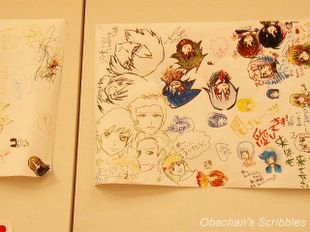Saturday, November 05, 2005
KOCHI MANGA FESTIVAL 2005 -PART 2-
 In the afternoon, I went to a sort of chalk talk session about how Japanese amine is accepted outside Japan. Here I’m going to summarize what I thought I understood there. Please keep in mind that my understanding may not be perfectly accurate and/or some nuance may be lost in my translation. Feel free to correct me if you find something strange or obviously wrong here. (The drawings in the photo were made on the spot by the visitors of this manga festival. They are not related to this calk-talk session, but I just wanted to post at least one photo here.)
In the afternoon, I went to a sort of chalk talk session about how Japanese amine is accepted outside Japan. Here I’m going to summarize what I thought I understood there. Please keep in mind that my understanding may not be perfectly accurate and/or some nuance may be lost in my translation. Feel free to correct me if you find something strange or obviously wrong here. (The drawings in the photo were made on the spot by the visitors of this manga festival. They are not related to this calk-talk session, but I just wanted to post at least one photo here.)In Japan, a growing number of local governments and government agencies are going in the direction of supporting manga/anime industry (though still not as much as they do in Korea). Especially Tokyo prefectural government considers Anime production as an important part of the local industry.
The development of animation followed somewhat different paths in different countries. In the U.S., the development has been largely influenced by Disney (for better or worse). In Japan, TV animation has developed in “serial-drama style” perhaps because of the influence of Osamu Tezuka, and also the fact that many of them were made based on original manga comics. In Europe, animation has developed as an art-form that artists use, thus sometimes the themes/storylines can be rather intricate. In Canada, there’s a "national" training center for animation and design, and animators from all around the world are studying there.
Japanese anime exported to foreign countries had to experience a dark age about 10 years ago. Their copyright was sold to local companies very cheap then, and those who bought the anime made whatever changes they wanted, including combining the stories/characters of several different anime. Now the situation is significantly improved and it is possible to prevent such brutal alterations.
The anime that made the biggest success in France was “Grendizer,” which achieved the viewing rate of over 90%.
Even though the audience was very small, I enjoyed the session very much. He told us about the hard times he had in the past, as a fanatic fan, before manga/anime became widely accepted and gained respect, and the story made us laugh.
What I’m seeing, I think, is the fact that people in and outside Japan have so much to express through and about manga/anime, and I see it as a positive thing. Or more precisely --- we can make it into a positive phenomenon if we can handle it properly. And I believe that the efforts are already being made not only in Japan but worldwide.
posted by obachan, 11/05/2005 05:36:00 PM


